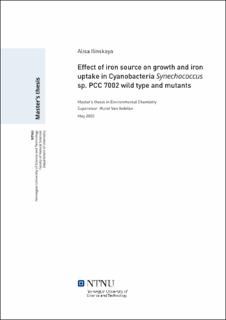| dc.description.abstract | Iron is an important trace element that is involved in biological processes and often acts as a limiting nutrient in the ocean. Because of low iron bioavailability in seawater, many organisms have shown ability to adapt to iron-deplete conditions by finding more efficient ways of acquiring iron from the environment (Fraser et al., 2013; González et al., 2018). This work studies response of cyanobacteria species Synechococcus sp. PCC 7002 to different iron conditions. This species has shown ability to use such iron acquisition mechanisms as release of siderophores and extracellular iron reduction (Årstøl and Hohmann-Marriott, 2019; Vogel, 2019).
To study the response of Synechococcus sp. PCC 7002 as well as role of both iron acquisition pathways in different iron conditions, culturing experiments were conducted. Wild type (WT) and deletion mutant cultures (ΔA2804 and ΔSidOP) were grown on two iron sources (FeCl3 and FeO(OH)) in two concentrations (5 μM and 100 nM). During the experiments, optical density of cultures as well as particulate and intercellular iron concentrations were analyzed.
This work is a part of PhD project of Annie Vera Hunnestad at Department of Chemistry which includes several experiments on Synechococcus sp. PCC 7002 cultures conducted throughout the years. The project involves additional analyses that are not presented in this thesis.
Based on the results of experiments, in iron-replete conditions all types of organisms showed their ability to sustain growth. Even though a more soluble iron source is generally preferred (in this case, FeCl3), with goethite (FeO(OH)) present in high concentrations cultures also showed significant growth. When iron concentrations were lower, iron source and its characteristics became more important together with type of mutation. In lower concentrations of more soluble FeCl3 siderophore-mediated iron uptake pathway may become more important. It can be suggested, that at low concentrations goethite becomes practically unavailable for all cultures. This implies that even wild type culture that can use both iron uptake mechanisms does not have significant advantage on this iron source. | |
